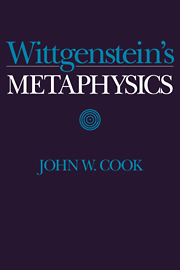Book contents
- Frontmatter
- Contents
- Preface
- List of Abbreviations
- Introduction
- Part I From Idealism to Pure Realism
- 1 Wittgenstein's Philosophical Beginnings
- 2 Neutral Monism
- 3 The ‘Objects’ of the Tractatus
- 4 The Essence of the World Can Be Shown But Not Said
- 5 What the Solipsist Means is Quite Correct
- 6 Pure Realism and The Elimination of Private Objects
- Part II The Metaphysics of Wittgenstein's Later Philosophy
- Part III Causation and Science in a Phenomenal World
- Part IV Logical Possibilities and the Possibility of Knowledge
- Part V The Past, Memory, and The Private Language Argument
- Name Index
- Subject Index
5 - What the Solipsist Means is Quite Correct
Published online by Cambridge University Press: 05 November 2011
- Frontmatter
- Contents
- Preface
- List of Abbreviations
- Introduction
- Part I From Idealism to Pure Realism
- 1 Wittgenstein's Philosophical Beginnings
- 2 Neutral Monism
- 3 The ‘Objects’ of the Tractatus
- 4 The Essence of the World Can Be Shown But Not Said
- 5 What the Solipsist Means is Quite Correct
- 6 Pure Realism and The Elimination of Private Objects
- Part II The Metaphysics of Wittgenstein's Later Philosophy
- Part III Causation and Science in a Phenomenal World
- Part IV Logical Possibilities and the Possibility of Knowledge
- Part V The Past, Memory, and The Private Language Argument
- Name Index
- Subject Index
Summary
In his pre-Tractatus notebooks Wittgenstein wrote: “This is the way I have travelled: Idealism singles men out from the world as unique, solipsism singles me alone out, and at last I see that I too belong with the rest of the world, and so on the one side nothing is left over, and on the other side, as unique, the world. In this way idealism leads to realism if it is strictly thought out” (NB, p. 85). In this chapter and the next we will be concerned with understanding Wittgenstein's intellectual travels: his transition from idealism to solipsism to a position beyond solipsism, which he calls “realism.” This final position, which we have already identified as neutral monism, will be discussed in Chapter 6. Here we will be concerned with his treatment of solipsism.
As I remarked in Chapter 1, Wittgenstein's early concerns were epistemological: he was eager to defeat the philosophical claim that there are many things one cannot know. This, very likely, was his reason for moving from idealism to solipsism. Idealism, in arguing that ‘material things’ are nothing but bundles of sense-impressions, undercuts skepticism regarding the existence of material things. And yet, because it allows that there may be ‘other minds,’ which are not given in one's experience, idealism leaves open the door to skepticism regarding other people. If another person – a friend or neighbor – is to be thought of as another mind, and is thus to be thought of as something that is not given in experience, then whether one has a friend or neighbor must remain unknowable.
- Type
- Chapter
- Information
- Wittgenstein's Metaphysics , pp. 55 - 68Publisher: Cambridge University PressPrint publication year: 1994



